How To Identify Rat vs Mouse: Understanding the Key Differences
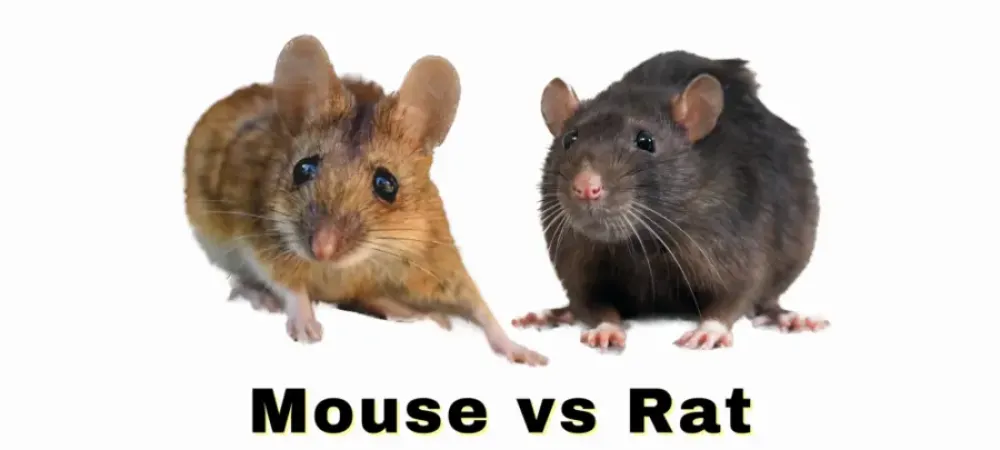
As a homeowner in Michigan, it’s essential to understand the differences between mice and rats—especially during the colder months when these rodents seek shelter in warm, cozy indoor spaces. If you've noticed signs of rodents in your home, such as scratching noises or droppings, it’s essential to identify whether you’re dealing with mice or rats. While these two creatures share some similarities, understanding their key differences can help you tackle an infestation more effectively. Let’s break down the differences between mice and rats based on size, appearance, behavior, and more, so you can protect your home this fall and winter in Michigan.
Common rats vs mice characteristics include:
Size and Appearance
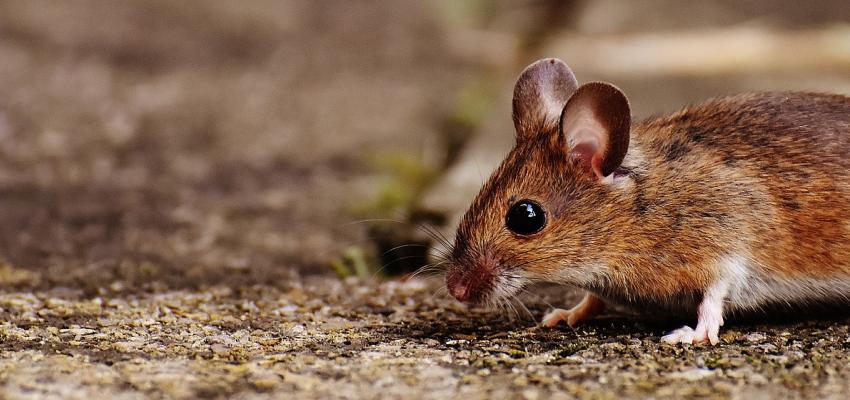
Rats
- Size: Rats are larger, measuring 9-11 inches in body length with tails ranging from 7-9 inches.
- Weight: Rats are heavier, typically 8-12 ounces.
- Color: Their fur can range from gray, brown, or black, often with lighter bellies.
- Face and Ears: Rats have blunt, broad faces with large, round ears.
- Tail: Their tails are thick, scaly, and noticeably shorter in relation to their body size compared to mice.
Mice
- Size: Mice are small, measuring between 5-7 inches in body length. Their tails are typically 3-4 inches long.
- Weight: They weigh around 0.5 to 1 ounce.
- Color: Mice often have gray or brown fur, with lighter bellies.
- Face and Ears: They have small, triangular faces with large, rounded ears.
- Tail: Their tails are long, thin, and hairless, often coated in fine scales.
Identification Tip
If you spot a rodent and it’s running around an open area, look at its body size. Mice (featured in the picture above) are much smaller, while rats are larger and bulkier. A large, robust body with a thick tail almost certainly indicates a rat. If the tail looks long and thin, it’s likely a mouse.
Habitat
Rats
Rats prefer larger areas like basements, crawl spaces, and sewer systems. They may even build nests under the foundation of your home or in storage rooms where there’s a plentiful food supply.
- Entry Points: Rats need larger openings (1/2 inch or more), and they often enter through pipes, vents, or cracks in the foundation.
- Michigan Consideration: In Michigan, rats are more likely to be found in urban areas, warehouses, or larger residential homes. If your home has a basement or access to drains, rats may find their way inside.
Mice
Mice are known for squeezing into tiny gaps. They nest in hidden, often insulated areas of your home, such as attics, crawl spaces, and behind kitchen cabinets.
- Entry Points: Mice can fit through gaps as small as 1/4 inch, so make sure to seal off cracks and holes in your home’s foundation, walls, or doors.
- Michigan Consideration: During Michigan winters, mice tend to seek shelter in homes, particularly in warm places like attics, under floor boards, or basements.
Identification Tip
If you notice rodents in hidden, insulated areas like attics or wall voids, you're probably dealing with mice. If they’re found in larger spaces or near the ground, especially around basements or sewer lines, they’re likely rats.
Behavior

Rats
Rats are naturally bold and social compared to mice. While they prefer nighttime activity, they are generally more comfortable being in the open and will often explore more of your home. Rats are excellent swimmers and can enter through drains or cracks in pipes, making them a serious threat to homes in Michigan, with basements or crawlspaces prone to water entry.
Mice
Mice are generally skittish and tend to be more active at night. They are curious creatures that will explore every nook and cranny of your home in search of food, but they avoid open spaces and prefer dark, secluded areas. Mice are known to be excellent climbers and can scale walls and even jump.
Identification Tip
If you notice active, bold rodents foraging in open spaces at night or traveling in a particular path, it's more likely a rat. Mice, on the other hand, will avoid wide-open spaces and are often heard but rarely seen.
Diet
Rats
- Preferred Foods: Rats are also omnivores, but they have a stronger preference for protein-rich foods like meat, cheese, or pet food.
- Scavenging: Rats tend to forage in basements, garages, and even under your house for discarded food or trash. They will also gnaw on items like soap, rubber, and electrical wires.
- Feeding Habits: Rats are known to take large portions of food, and they can hoard it in hidden locations like behind walls or under furniture.
Mice
- Preferred Foods: Mice are omnivores and nibble on grains, seeds, fruit, and even sweets. They prefer nibbling on small amounts of food at a time.
- Scavenging: They often forage in pantries, storage rooms, or kitchens, especially around food scraps and leftovers.
- Feeding Habits: Mice will eat a variety of foods but tend to stick to whatever is readily available and easy to get.
Identification Tip
If the food in your pantry is being nibbled on by small creatures with small bites, it’s likely a mouse. However, if larger portions of food are being taken and there are signs of gnawing on non-food items, it's a sign of rats.
Droppings
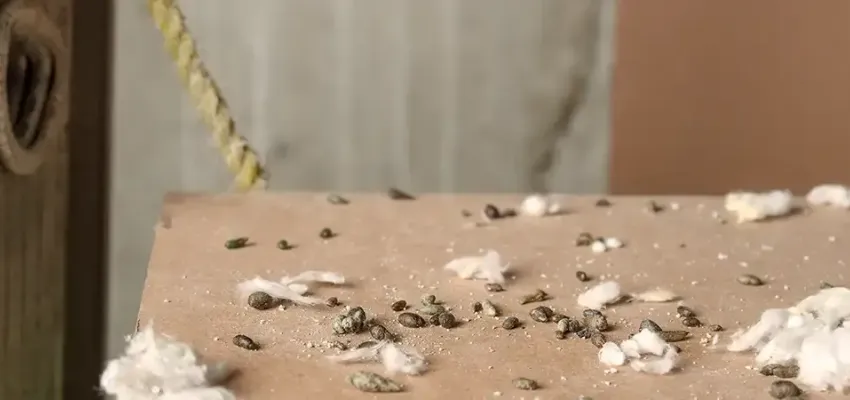
Rats
Rat droppings (featured in the picture above) are larger, about 1/2 inch long, and shaped more like a large pellet, often with blunt ends. Rat droppings are typically found in areas where they travel often, such as along walls, near trash cans, or in basements.
Mice
Mice droppings are small, dark, and pellet-shaped, usually around 1/4 inch long, shaped like grains of rice. You’ll find them in areas where mice frequent, such as in pantry corners, inside cabinets, along baseboards, or near food sources.
Both mice and rats are known to leave droppings in places where they travel, which can be a major sign of an infestation, especially in kitchens or basements.
Breeding
Rats
Rats breed rapidly, with female rats capable of having up to 7 litters per year. Each litter can contain 6-12 pups. Unlike mice, rats often establish colonies, especially in areas like basements or under your home’s foundation. It is important to act quickly on a rat infestation, as they can breed quickly and establish a larger colony.
Mice
Mice reproduce quickly, with females capable of having up to 10 litters per year, each containing 3-14 babies. With a short gestation period (around 19 days), a mouse population can grow exponentially in a short amount of time. In Michigan, where they can breed year-round indoors, a small infestation can grow rapidly, especially in the cooler months.
Because both species breed quickly, an infestation in Michigan can escalate from a minor problem to a serious one in no time.
Nests
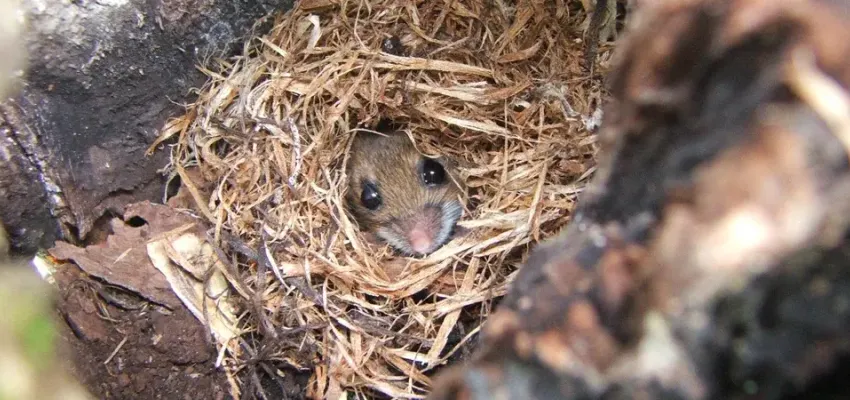
Rats
- Location: Rats are less picky about the location of their nests but prefer larger, hidden areas. They often build nests in basements, crawl spaces, and attics, as well as in sewers or under foundations. If they can find dark, undisturbed areas such as storage spaces, behind appliances, or under large furniture, they will nest there.
- Construction: Rats will use similar materials as mice but are known to tear up larger objects like cardboard, wood, or even furniture to create their nests. They can also use shredded fabric, paper, and insulation. Rats are more likely to gather food in their nests, as well.
- Size and Shape: Rat nests are larger than mouse nests, often measuring several inches in diameter. They are generally bulky, irregularly shaped, and can expand as the rodent colony grows.
Mice
- Location: Mice tend to build their nests in secluded, hidden areas that provide shelter and insulation. Common locations include behind walls, inside attic insulation, beneath floorboards, inside stored items, or in cabinets and drawers.
- Construction: Mice use materials they can find around your home to build their nests. These materials often include shredded paper, fabric, insulation, cotton, and even small pieces of food packaging. They will also use their own fur to help line the nest for warmth.
- Size and Shape: Mouse nests are usually small, compact, and round, measuring only a few inches in diameter. They are designed to keep their young safe and insulated.
Identification Tip
If you discover a small, neatly arranged nest made from soft, shredded materials in an isolated area, it’s likely from a mouse (as featured in the picture above). However, if the nest is larger, less organized, and found in a more conspicuous location, such as a basement or crawl space, it’s a sign of a rat infestation. A rat’s nest will also often have an unpleasant, musky odor due to the larger number of rats living in close quarters.
Signs of Infestation
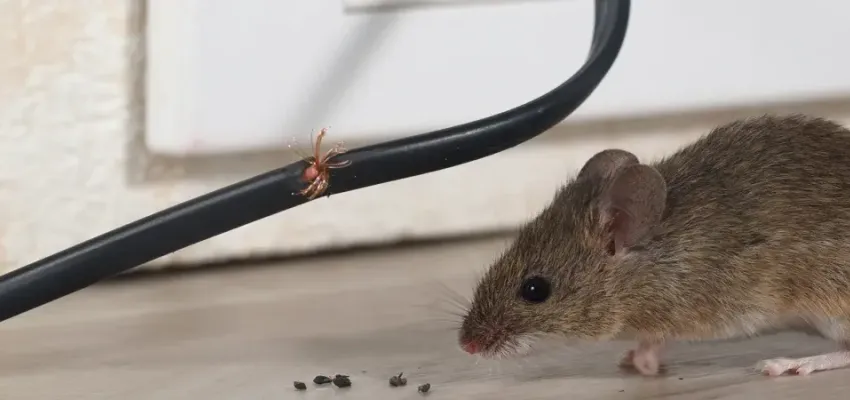
Rat Infestation
- Droppings: Larger, blunt-ended droppings about 1/2 inch long found in hidden areas, along walls, or near food sources.
- Gnaw Marks: Rats chew on a variety of materials, including wood, plastic, and wires. Gnaw marks may be visible on furniture, baseboards, or in pantry items.
- Footprints: Rats leave larger, more noticeable tracks in dusty or dirty areas as they move around.
- Noise: Scratching or scurrying noises, particularly in walls, ceilings, or attics, especially during the night.
- Nests: Larger, more substantial nests made from shredded materials (such as paper, fabric, or insulation) often found in dark, hidden places like basements, crawl spaces, or attics.
- Urine Stains: Rats may leave behind urine stains or strong, musty odors, particularly in areas they frequent.
- Visible Rats: Larger rats may be seen in the open at night foraging for food or water. They are often bolder than mice.
- Damage to Property: Chewed wires, insulation, and even furniture as rats need to gnaw to keep their teeth from growing too long.
Mouse Infestation
- Droppings: Small, rice-shaped droppings (1/4 inch long) typically found in pantries, along baseboards, or near food sources.
- Gnaw Marks: Mice chew on smaller items such as cardboard, packaging, and food containers. You may find holes or nibble marks in food bags.
- Noises: High-pitched squeaks, scurrying, or scratching sounds, especially at night when mice are more active. Often heard in walls or ceilings.
- Nests: Small, more delicate nests made from shredded paper, fabric, or insulation in hidden corners, attics, or basements.
- Visible Mice: You may spot mice quickly running across floors, especially in kitchen areas, particularly at night when they forage for food.
- Footprints: Small, fine tracks in dust or dirt left by mice as they travel around your home.
- Urine Marks: A strong ammonia-like odor and visible urine trails left in high-traffic areas.
- Chewing on Food: Mice typically gnaw on smaller food scraps or nibble at pantry items, leaving holes in food packaging.
Identification Tip
- Rats tend to be more visible, larger in size, and more destructive (e.g., chewing through thicker materials).
- Mice are smaller, more elusive, and often cause damage to lighter materials, such as paper, cardboard, or fabric.
If you notice several of these signs in your home, it's important to take action quickly to avoid further infestation.
Health Risks
Both mice and rats pose significant health risks to homeowners. They are known carriers of diseases like salmonella, hantavirus, and leptospirosis, and can spread these through droppings, urine, and saliva. In Michigan, where seasonal changes bring more moisture and pests, rodent-borne diseases are a real concern for families.
Which is Worse: Rats or Mice?
Both rats and mice present significant pest issues, but rats are generally considered worse due to their ability to carry more severe diseases, cause greater structural damage, and prove more challenging to eradicate. Rats have larger, stronger jaws for gnawing through tough materials and are cautious, making them difficult to control. Mice, while smaller and able to breed rapidly, pose less of a health risk and typically cause less structural damage, though their sheer numbers can also lead to substantial problems.
Whether you need help identifying rats vs mice, are seeing signs of rodent activity, or are looking to protect your home from rats and mice, our team at All Seasons Pest Control offers professional rodent control services in the Detroit area offer targeted solutions for rats and mice, ensuring effective eradication and peace of mind. If you're in the Detroit area, call today to get a free quote on rodent control!



